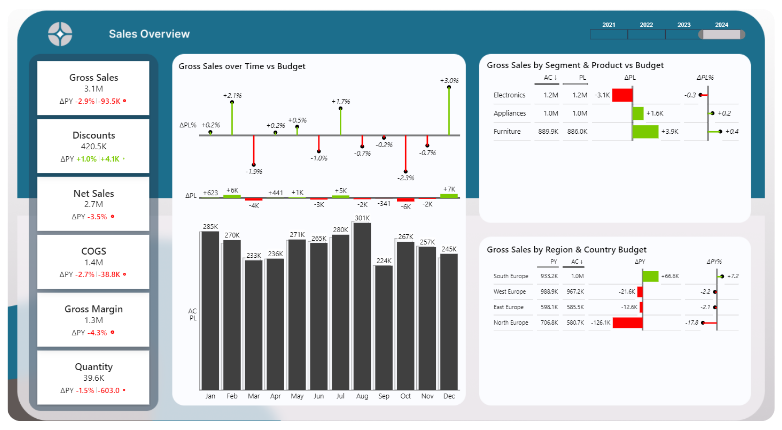Introduction
Learning Power BI is an exciting journey. But how long does it take to learn Power BI? It depends on your background, dedication, and the specific areas you wish to focus on. Some say it takes 7-10 days to get the basics down, while others, even after years, find themselves learning new tricks every day. But that’s the beauty of Power BI—it’s a dynamic, ever-evolving platform! Whether you’re aiming to create your first dashboard or dive deep into complex DAX formulas, this guide will help you understand what to expect and how to make the most of your learning journey.
Personally, I have been using Power BI for more than for years. I would say I am fairly good at what I am doing. Afterall, I am earning my money as a freelance Power BI developer. However, there is so much to know and learn in the Power BI world. Starting from Dashboard Design, to Data Modelling, to Dax and measures, to publishing to storytelling and much more. Plus, the IT landscape is changing fast and now the next part for me is learning how to use Power BI in the Microsoft Fabric environment more efficiently.
In a world where data is king, being proficient in Power BI can make you a highly valuable asset. From beginners looking to break into data analytics to seasoned professionals seeking to sharpen their skills, there’s something for everyone to learn. Let’s explore the time it takes to become skilled in Power BI and what factors might influence your learning pace.
How I started learning Power BI – My Journey
I began my Power BI journey as a logistics analyst with almost no real experience—just a few online classes under my belt and absolutely no clue about best practices like star schema, data modeling, or how to optimize refresh speed. I remember being overwhelmed at first, not knowing where to start or what to focus on. But I was determined to learn! I threw myself into constant upskilling through platforms like Udemy, DataCamp, and yes, YouTube as well. It wasn’t always smooth sailing, but with every lesson and every bit of practice, I slowly built a solid foundation. Becoming really, really good at Power BI takes years; each project gets you one step closer, adding new skills to your toolkit. Since 2022, I’ve been a full-time Power BI developer, working with clients in Germany and the US on a fully remote basis. My time and investment have truly paid off!
If you’re starting your own Power BI journey, I recommend heading over to Kaggle.com for inspiration, or better yet, create your own dataset with ChatGPT—check out my article on how to do this. And don’t just keep your progress to yourself—share your learning journey on LinkedIn! It’s a great way to gain visibility and connect with others in the field. Also, consider building a portfolio by participating in challenges; I’ve found Maven Analytics to be a fantastic platform for this—here’s the link to get started. Keep pushing forward, and remember that every project brings you one step closer to becoming the expert you want to be!
So How Long does it take to learn Power BI? Well, that depends on a few factors. See details below 😉
Understanding the Basics of Power BI
To start your Power BI journey, you first need to understand what it is and why it matters. Power BI is a business intelligence tool by Microsoft that allows you to transform raw data into insightful, interactive visualizations. It consists of several components, including Power BI Desktop, Power BI Service, Power Query, and DAX (Data Analysis Expressions).
Getting started with Power BI involves familiarizing yourself with its interface, learning how to import data from different sources, and creating your first visualizations. This initial phase might feel overwhelming, but once you get comfortable with the basics, you’ll find it’s easier to navigate. Within a few days to a week, most beginners can create basic reports and dashboards by following tutorials and experimenting with different features.
- Key Components of Power BI: Power BI Desktop, Power BI Service, Power Query, DAX.
- Initial Learning Curve: Getting comfortable with the interface, importing data, and creating simple visualizations.
- Importance of Basics: Building a strong foundation helps in mastering advanced topics later.
How Long Does It Take to Learn Power BI Basics?
The time required to learn Power BI basics largely depends on your prior experience and the time you dedicate to learning. For someone new to data analysis tools, it might take 7-10 days of consistent practice to grasp the fundamental concepts of Power BI, such as data import, basic visualization, and report creation. If you already have experience with tools like Excel or SQL, you may find it easier and quicker to get up to speed.
However, simply completing a few tutorials won’t make you an expert. Engaging with real-world data, tackling unique challenges, and experimenting with different scenarios is key to cementing your knowledge. Think of this stage as learning a new language: you can pick up the basics quickly, but fluency requires continuous practice and exposure.
- Estimated Time Frame: 7-10 days for basic understanding.
- Impact of Previous Experience: Faster learning if familiar with Excel, SQL, or similar tools.
- Importance of Practice: Hands-on experience is crucial for mastering the basics.
You want to see some portfolio project and real use cases? Check out my portfolio page!

Factors That Impact Your Power BI Learning Time
Several factors can influence how long it takes you to learn Power BI. If you already have experience working with data tools or come from an Excel-heavy background, you might find Power BI’s interface familiar and easier to grasp. However, if you’re entirely new to data analytics, expect a steeper learning curve.
Time availability and commitment also play a big role. Are you dedicating an hour a day to learning, or are you diving in full-time? Your learning style matters too—some people thrive with self-paced online courses, while others benefit from structured, instructor-led training. And don’t forget the importance of access to quality resources like tutorials, community support, and real-life projects.
- Prior Experience: Familiarity with Excel, SQL, or data tools can accelerate learning.
- Time and Dedication: The more time you invest, the faster you’ll progress.
- Learning Style and Resources: Self-paced study, instructor-led training, and access to quality resources matter.
Mastering Advanced Power BI Skills: How Long to Learn?
Once you’ve got the basics down, it’s time to explore advanced topics like DAX, Power Query, and complex data modeling. Mastering these areas can take months or even years, depending on your commitment and the complexity of your projects.
Advanced skills involve creating complex measures, optimizing DAX for performance, understanding context transitions, and building robust data models. It’s a continuous learning journey, as Power BI frequently updates with new features and functionalities. This is where you truly appreciate that Power BI isn’t just a tool but a mindset—one where you’re always exploring, experimenting, and evolving.
- Advanced Topics: DAX, Power Query, data modeling, performance optimization.
- Time Frame for Mastery: Months to years, depending on commitment and project complexity.
- Continual Learning: New features and updates make ongoing learning essential.
The Continuous Learning Journey with Power BI
With Power BI’s frequent updates and new functionalities, it’s virtually impossible to become a “true expert” in every aspect. Even seasoned professionals find themselves learning and adapting to new tools and techniques. That’s part of the excitement—there’s always something new to discover, making the journey rewarding and engaging.
Don’t be discouraged if you don’t feel like a master right away. Embrace the process of continuous improvement. Join Power BI communities, follow industry leaders, and stay updated with the latest features. Remember, every challenge is an opportunity to grow your skills and stand out in a competitive job market.
- Why No One Is a True Expert: Constant updates and new functionalities keep everyone learning.
- The Beauty of Continuous Learning: Discovering new things every day keeps the journey exciting.
- Staying Updated: Engage with communities, follow experts, and keep learning.
Tips to Accelerate Your Power BI Learning
Want to speed up your Power BI learning journey? Leverage both free and paid resources. Microsoft Learn, LinkedIn Learning, and YouTube offer a wealth of tutorials for every skill level. Don’t just stick to theory—practice with real-world data to face diverse challenges and sharpen your skills.
Networking with other Power BI users is also a great way to learn. Engaging in community forums, attending webinars, and connecting with experts on LinkedIn can provide invaluable insights and tips. Remember, learning Power BI isn’t just about mastering technical skills; it’s also about understanding how to apply those skills to solve real business problems.
- Use Quality Resources: Microsoft Learn, LinkedIn Learning, YouTube, community forums.
- Practice with Real Data: Build models with diverse datasets to tackle different challenges.
- Network with Experts: Engage with communities, attend webinars, and follow industry leaders.
Common Pitfalls to Avoid When Learning Power BI
When learning Power BI, avoid the trap of focusing too much on one aspect, like visuals, while neglecting data modeling or DAX. A well-rounded approach is essential to mastering the tool. Additionally, be wary of quick-fix promises like “become a pro in 10 hours.” Mastery takes time, and understanding the fundamentals is key.
Many beginners also fall into the habit of following tutorials without grasping the “why” behind certain techniques. Make sure to understand the logic behind the steps you’re taking. This will help you think critically and creatively when faced with unique challenges in your projects.
- Avoid Narrow Focus: Balance learning across visuals, data modeling, and DAX.
- Beware of Quick-Fix Promises: Quality learning takes time; avoid shortcuts.
- Understand the ‘Why’: Don’t just follow tutorials—grasp the reasoning behind techniques.
Creating Your Power BI Learning Plan for 2024
To make the most of your Power BI journey, it’s important to set realistic goals based on your current skills and career objectives. If you’re a beginner, start with foundational topics like importing data and creating simple visualizations. Gradually move on to intermediate topics such as data modeling and DAX.
For more experienced learners, focus on advanced areas like optimizing DAX measures, setting up data infrastructures, and preparing ETL flows. Use time management strategies like the Pomodoro technique to ensure consistent progress and avoid burnout. Remember, Power BI is a journey, not a race!
- Set Realistic Goals: Align learning objectives with your current skill level.
- Choose a Learning Path: Beginner, intermediate, or advanced based on experience.
- Time Management: Use strategies like the Pomodoro technique to maintain consistent learning.
Conclusion:
Mastering Power BI is not a sprint; it’s a marathon! Depending on your background, goals, and dedication, your learning time may vary, but with the right approach, you can make steady progress. Remember, even experts are always learning new things with Power BI. Start with the basics, practice regularly, and keep challenging yourself with more complex tasks. The more you learn, the more valuable you become in today’s data-driven world. Ready to start your journey? Dive into your first lesson today, and don’t forget—enjoy the process!

